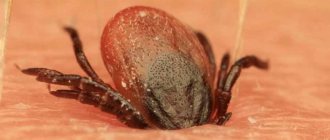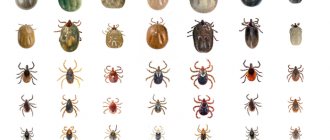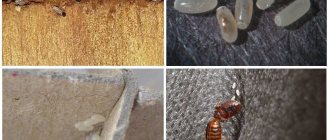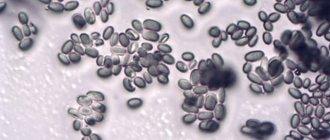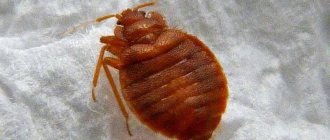Where does the tick live and how does it live?
The tick feeds on the blood of animals and humans.
It lives in humid mixed and deciduous forests, where there is dense undergrowth and tall grass. Its habitat gradually moved to large cities, and now covers forest parks, parks and garden plots. Sitting on blades of grass and branches, the tick waits for prey - large and small animals, as well as humans. The parasite is able to sense the approach of an animal or person at a distance of 10 meters. From the height of the grass, it clings to a passing victim, but never falls from above. Mild winters stimulate the earliest activation of ticks. Hot summers speed up their life cycle. The increased length of the growing season affects the growth of the tick population and their autumn activity.
Tick season begins in early spring and ends in late autumn. The tick is a fairly hardy arachnid creature; it is capable of active life at temperatures ranging from 6 to 8 degrees Celsius. There are many ticks where there is food for them - small warm-blooded animals and birds. The first phase of tick activity ends in July, and after a month's break, the second, no less active autumn phase begins.
The tick has a complex cycle. He only eats a couple of times in his life. Adult females look for animals or humans so that they can go into hibernation after drinking blood and lay new eggs in the spring. With the onset of autumn cold, ticks fall into torpor, hiding in the grass, dead wood, under trees, the main thing is that the height of the forest floor helps them survive the winter.
Vaccination against tick-borne encephalitis
The vaccine should be given long before the tick season begins. You should start in November and give the next injection in the spring. This method helps to achieve the development of good immunity during the spring-summer exacerbation period. Immunoglobulin injections do not guarantee that a person will not become infected with encephalitis. There are precedents when vaccinated people also got sick from it. This may occur due to an incorrectly constructed vaccination schedule.
A full course after two vaccinations involves revaccination with one more, after which one vaccination is given every 3 years.
There are known precedents when people became infected not through ticks, but through animal milk. In our country, a surge in such cases was associated with the poor post-war years. Then goat's milk became a source of infection. The animal itself does not suffer from the disease. Therefore, it is important to boil any milk before drinking.
The development of immunity can be affected by diseases to which a person is susceptible: diabetes, oncology, influenza. This once again proves that the vaccine is not a guarantee. The situation is also influenced by the type of virus, the location of the bite, and the dose of virus in the tick. If these factors are unfavorable, the disease develops quickly and leads to negative consequences.
Therefore, it is so important not to neglect protective equipment - special suits, aerosols. Doctors have a full arsenal of medications and antibiotics at their disposal. The decisive factor in determining the disease and prescribing the necessary treatment is how quickly the bitten person goes to the clinic.
Tick activity in August and September
An important condition for the existence of ticks is the presence of optimal humidity. Excessively dry or too humid places are not to their liking. Hungry female ticks are active until June. The period of diapause (temporary physiological rest) begins from late June to early August. Already at the end of August and the beginning of September there is a new round of activity of ticks, which in the first half of summer did not have time to feed and leave offspring. The answer to the question of whether there are ticks in August is clear - yes, they exist and are quite active.
The population size and activity of ticks in autumn is influenced by human activity. Foci of encephalitis exist due to ticks, which parasitize animals and transmit the virus. Measures to combat vectors in forests are carried out in early spring, immediately after the snow melts. Ticks that survive after processing forests look for food even more actively in the fall. Where such treatment is not carried out, there are especially many ticks.
An increase in the number of ticks in autumn may be related to the weather. Mild winters and early springs, high humidity and cool weather in summer allow ticks to overwinter well and reproduce in more favorable conditions. If Indian summer begins at the end of October, the activity of ticks does not subside. Until the first cold weather, they will search for their prey. And only when the thermometer drops to 5 degrees do ticks go into hibernation.
Are ticks dangerous in September?
The summer season for pensioners continues in the fall, because the weather is relatively warm. Working people go to the Moscow region, Leningrad region and other regions on weekends to breathe fresh air, barbecue, and take a walk in the forest. In autumn, nature falls asleep, many insects become less active, and sometimes literally sleepy, like flies.
How do ticks behave? They are quite active
and are waiting for their prey. The female needs to drink the blood of a large creature - a person or an animal such as a dog - in order to reproduce and lay eggs.
At the end of August-September, the weather is conducive to the active lifestyle of ticks, the sun is no longer so hot and they sit on the leaves waiting for a victim to pass by. A tick bite for a person carries the risk of contracting a serious infection such as Borreliosis (Lyme disease) or Encephalitis. A tick bite on a dog is also dangerous, even fatal.
Are ticks dangerous in the fall?
In addition to the risk of becoming infected with the dangerous encephalitis virus, there are other dangers. The tick is capable of suppressing the human immune system, which leads to the possibility of contracting additional infections. Already in the first minutes after the bite, the virus enters the bloodstream, so with the arrival of autumn there is no need to relax. Tick activity in autumn is less pronounced than in spring, but being bitten in autumn is no less dangerous than in spring or summer. Low temperatures above zero are not scary for ticks. Even after night frosts, when the sun warms up, the warmth will be enough for them to resume their activity.
In summer, female ticks lay eggs, which turn into larvae a month later. The larvae feed on the blood of small animals such as mice and birds. Having had enough, they fall off, climb into the forest humus, molt and transform into nymphs. Nymphs after hibernation look for larger prey; they drink blood from forest inhabitants such as foxes or raccoons. Having received the necessary portion of blood, they hibernate, and only the next year the nymph transforms into an adult (female or male).
Females are much larger than males; they need to be saturated with blood for about 6–7 days. The volume of blood consumed is one hundred times the weight of the individual itself. Male ticks need much less time to satiate. Their main concern is finding females to mate with. Unlike forest mosquitoes and midges, the tick acts unnoticed. Its bite cannot be felt. It is the fully formed tick, to which the virus has passed from small rodents at the larval and nymph stages, that is most dangerous to humans as a carrier of infection.
Seasonal changes in tick activity
The activity of ixodid ticks has a pronounced dependence on the time of year (seasonality). In the central and more northern regions of Russia, where seasonal climatic fluctuations are most noticeable, special periods of slower activity - diapause - are clearly expressed in the biological rhythms of the parasite.
There are two types of diapause:
- Morphogenetic;
- Behavioral.
Morphogenetic diapause is associated with the loss of activity of the primary life stages of ticks. Most often, it is expressed by a slowdown in the process of hatching of larvae from eggs and a slowdown in molting in nymphs saturated with blood. This behavior allows the arthropod to synchronize its life rhythms with seasonal changes in temperature and humidity.
During morphogenetic diapause, ticks are inactive and not as dangerous to humans as during other periods.
It is important to know
The transmission of infectious disease agents from ticks to humans can occur not only at the moment of physical contact or bite. There are frequent cases of infection with tick-borne encephalitis from raw dairy products obtained from infected goats, sheep, and cows. In turn, livestock can become infected either through a tick bite or when an infected parasite enters the body through the digestive system. Thus, there is a possibility of infection even during diapause.
Behavioral diapause is characteristic of adult ixodids, and is expressed in a decrease in aggression and loss of activity during the search for food. This type of diapause is associated with seasonal changes in ambient temperature and day length.
It is also useful to read: How to distinguish an encephalitis tick from a regular (non-contagious) parasite
There are often cases when several natural and climatic factors overlap each other and cause long-term behavioral diapause in forest ticks. Under such conditions, the tick season subsides quite quickly, and adult ticks go into the winter hungry.
During diapause, ticks do not pose a serious danger to humans, since they are in an inactive state and do not hunt.
On a note
During the period of diapause, especially during wintering, ixodid ticks' resistance to the adverse effects of temperature and humidity increases many times over.
In early spring, after the snow melts, the peak physiological activity of adult individuals occurs. During this period, domestic animals most often suffer from tick bites - hunting dogs, as well as small livestock.
The risk of contracting infectious diseases through contact with ticks increases many times during the first warm days of spring. This is due to the fact that a long diapause is sharply replaced by increased activity of mites when the average daily temperature becomes positive. Prolonged winter abstinence from food requires a large expenditure of vitality, so in the spring the parasites activate the mechanism of activation and increased aggression.
The reactivation mechanism in ixodids, triggered in early spring, forces them to hunt even when the snow cover has not completely melted. During this period, the victims of ticks are domestic grazing animals that go out in search of vegetation emerging from under the snow.
The second peak of tick activity is observed in early autumn, when the average daily temperature and humidity are most favorable for spending most of the time in guarding mode. The largest number of tick bites is recorded at the end of summer and reaches a peak at the beginning of autumn, when the days are still quite warm, but there is no longer sweltering heat and lack of moisture.
In mid-summer, especially during dry seasons, parasites are less aggressive, since the upper grass layers have too low humidity and strong exposure to sunlight. Hunting individuals are often forced to descend into the lower grass layers, where the microclimate is more favorable. Under such conditions, the lurking type of hunting is ineffective, and most parasites are forced to reduce their activity in searching for prey.
Tick season 2021
If the tick does not die for reasons beyond its control, then it can live up to 8 years. This means that in the climate of the Central region of Russia it must winter somewhere. In autumn, ticks burrow into the top layer of humus and wilted grass, and climb under the bark of trees, where they fall into suspended animation. In spring, weather conditions serve as a signal for exiting hibernation. It depends on them when the tick season begins in 2021. To awaken ticks you need to:
- The snow has melted.
- A stable temperature has established itself above +10° C.
The awakening of ticks occurs gradually and geographically unevenly. In thawed areas heated by the sun, ticks can wake up much earlier than the official start of the tick season for a particular area. This explains the early appearance of the first reports of parasite bites.
How do you know if ticks are awake?
To find out if ticks are active in your area, take a white piece of cloth the size of a hand towel and run it over the ground or the first green area where insects are likely to be present. If ticks are awakened, several individuals will most likely end up on the material. The original version of this method recommends using a waffle towel placed on a pole like a flag, but you can limit yourself to any fleecy fabric that the insect can cling to.
If you do not want to experiment on your own or are interested in the question purely theoretically, the easiest way to find out about the awakening of ticks is to look through the local media or your regional Rospotrebnadzor website for the first reports of bites.
Methods of protection against ticks
The best way to protect yourself from blood-sucking parasites is not to go into the forest and spend the period of tick activity at home. This, of course, is not an option. Therefore, you need to prepare in other ways:
- clothing should be tight and closed;
- pants should be chosen with elastic at the calves so that the tick cannot crawl further;
- the jacket should be thick, also preferably with an elastic band at the wrists;
- shoes - high and closed.
Another important point is that you need to constantly inspect your clothing for ticks already attached. They are more visible on light-colored clothes, so it is recommended to choose a wardrobe in light colors.
Avoid wandering into dense grassy areas and stick to well-trodden paths and paths.
Precautions against tick bites
Periods of maximum tick activity
For those who are interested in when the tick season begins and ends, the answer is from April to October. With the onset of cold days, insects hibernate. They wake up in early spring. During the spring period when ticks are active, insects are the most aggressive, and therefore dangerous.
Having emerged from hibernation, they begin to intensively search for warm blood, without which it is difficult for them to wake up and begin to reproduce. Insects feed on the blood of both animals and humans.
A table of tick activity by month is presented below.
| Month | Activity | Note |
| April | 100% | Extremely aggressive. They bite hard and often because they are hungry |
| May | 98% | |
| June | 87% | |
| July | 75% | Moderately active |
| August | 85% | |
| September | 92% | Extremely aggressive. Eating before hibernation |
| October | 97-100% |
As can be seen from the table of tick activity by month in the Moscow region, insects show maximum aggression in those seasons when wet weather prevails. They feel great in shaded and moist deciduous and mixed forests. They thrive in thick grass and willow. Therefore, ticks in September and early spring are localized:
- in windbreaks;
- on the banks of rivers and the bottom of ravines;
- along forest paths overgrown with thick grass;
- on forest edges and parks.
But in fact, you can “catch” parasites anywhere during the periods when ticks are active - mid-April to mid-late October. Many contemporaries suggest that insects fall on them from the branches of trees and bushes. But this opinion is wrong. Hiding in the thickets, blood-sucking parasites literally rush at the victim who is nearby. They:
- from the first frost, when ticks cease to be active, they begin to actively hide in secluded places, preparing for hibernation;
- afraid of direct sunlight;
- love ambient temperatures up to 210C (forest cool);
- When the tick season begins, they bite very painfully, biting through a fairly large wound on the skin.
We have found out in what month and when exactly ticks are active, now we will find out how dangerous they are for animals and humans.
How dangerous are blood-sucking insects?
We have already found out that ticks are quite active in the Moscow region in September. Moreover, they are aggressive because they are preparing for hibernation. Their bites are unpleasant and dangerous for two reasons:
- Insects are carriers of viruses. Depending on the location of the parasite and its variety, it can cause infection of a healthy body with various viral infections - borreliosis, typhus and tick-borne relapsing fever, encephalitis, Crimean fever (hemorrhagic), babesiosis, spotted fever, etc. Answering the question, are they dangerous? ticks in the fall for humans, let's say yes.
- Insects can cause various diseases. It is quite difficult to remove a parasite that has been absorbed into the skin. Especially when a person starts to panic. In 7 out of 10 cases, the head remains in the wound, which becomes the cause of pustular lesions. Forest ticks in the fall are dangerous due to irritation and allergic reactions.
Young children and people with allergies can be significantly harmed by the bite of a single blood-sucking insect. The area of skin lesions can reach 1 cm or more.
Therefore, the question of whether ticks are dangerous in September in the Moscow region is as relevant as the question of the danger of insects in the spring-summer season. More often parasites transmit encephalitis. This is a very severe and fast-acting disease of viral etiology.
It affects the nervous system of a person or animal. The main complication of untimely treatment is irreversible changes in the brain. Therefore, you should be concerned not about whether there are ticks in September, but what they look like, how to get rid of them and protect yourself.
Let's look at these problems in more detail.
What does a blood-sucking parasite look like?
Having found out whether there are ticks in the Moscow region in September, we will learn to recognize the “enemy”. The insect has an arachnid appearance and a strongly flattened body 3-25 mm long and weighing 3-4 mg. The size of the body depends on the species. Moreover, females of all morphotypes are significantly larger than males.
During the active period of ticks, insects drink several times their body weight in blood. Their body spreads out in width, acquiring an ovoid shape. After feeding, the weight of the parasite can reach 40-500 mg. By the time tick season ends, the ticks look like the photo below.
Features of the body structure of the parasite:
- sharp trunk;
- organs of vision are absent. Instead, insects have well-developed receptors. During the active season of ticks, it is with their help that the blood-sucking parasite catches the smell of warm blood;
- four pairs of tenacious and mobile limbs;
- the claws on the feet have webbed suckers. During tick activity, the suckers help to stay on the victim's body;
- limbs consist of six segments;
- the respiratory plates are located at the back (behind the fourth pair of limbs);
- dorsal shield protecting the head.
Once again we will answer the question of whether there are ticks in the fall that suck blood and carry viral diseases. Yes, there are, and they are very active.
Therefore, experts recommend checking the skin for the presence of embedded parasites after every walk in the forest or in tall grass. The external characteristics of arthropod insects are described above.
The color of the cover ranges from light brown and brownish-red to black. After eating, the body color is dark gray. Remember: ticks are present in the fall and they are just as active and dangerous as in the spring.
Symptoms of encephalitis after a tick bite
An interesting fact is that only females suck blood. At the same time, they can increase in size by 100 times. Nature endowed them with a more protective cover and tenacity.
Female ticks in August or April (the season is not important) quickly move through the grass and clothing to unprotected areas of the skin. Here they can sit and absorb blood for up to 10 days.
Scientists know that male ticks were also active in September, but their presence on the victim was short-lived. The fact is that they are not adapted to suck blood for a long time.
Since females need to feed in order to give birth, the answer to the question of whether there are ticks in August is yes. They imperceptibly dig into the skin, making a large bite (relative to their body size). At this point, their salivary glands secrete a strong anesthetic substance.
Because of it, in the first few minutes the victim does not feel pain, allowing the female to dig into the skin. Are ticks really that dangerous in September or any other month of the active period? Dangerous if infected with viruses. Pathogenic organisms are contained in insect saliva.
Therefore, at the moment of the bite, infection occurs.
Symptoms of tick-borne encephalitis are as follows:
- increased body temperature;
- severe drowsiness and fatigue;
- increased weakness;
- increased sweating even during periods of inactivity.
When figuring out whether ticks are dangerous in the fall and spring-summer period, remember that experts have calculated that only 5-9% of blood-sucking insects are infected with encephalitis and other viruses.
But despite the low probability of contracting serious illnesses, it is worth protecting yourself from ticks in August, because they are dangerous and cause unpleasant skin lesions and allergies.
How to protect yourself from tick bites?
During the period when ticks disappear from the forest, additional skin protection is not needed. Insects hide and fall asleep. Therefore, before you go for a walk, find out whether there are currently ticks in the thickets and forest. If they are active then:
- Wear clothes made of thick fabrics with long legs and sleeves.
- Wear a hat.
- Wear tight-fitting shoes. To find out whether there are ticks in the forest now, you don’t have to ask a specialist. Just look at the thermometer. If the temperature
- Tuck your trouser legs into your socks.
- Choose a shirt with thick cuffs.
- Treat bare areas of the body and clothing adjacent to them with special compounds.
If you are wondering whether ticks are dangerous for people in August because you plan to be a frequent visitor to the forest belt, then it makes sense to get vaccinated against encephalitis. Otherwise, doctors recommend not to neglect the use of repellents.
Having decided how dangerous ticks are in August, take on board several effective drugs - “Tornado-anti-tick”, “Permanon”, “Tick-kaput aerosol” and others. Some drugs kill parasites, others repel them, and others have a combined effect. The choice is up to you.
The main thing is not to neglect them during the period when ticks are active in August and September. And if you notice redness in the affected area and rapid fatigue, consult a doctor immediately.
What does a blood-sucking parasite look like?
Having found out whether there are ticks in the Moscow region in September, we will learn to recognize the “enemy”. The insect has an arachnid appearance and a strongly flattened body 3-25 mm long and weighing 3-4 mg. The size of the body depends on the species. Moreover, females of all morphotypes are significantly larger than males. During the active period of ticks, insects drink several times their body weight in blood. Their body spreads out in width, acquiring an ovoid shape. After feeding, the weight of the parasite can reach 40-500 mg. By the time tick season ends, the ticks look like the photo below.
Features of the body structure of the parasite:
- sharp trunk;
- organs of vision are absent. Instead, insects have well-developed receptors. During the active season of ticks, it is with their help that the blood-sucking parasite catches the smell of warm blood;
- four pairs of tenacious and mobile limbs;
- the claws on the feet have webbed suckers. During tick activity, the suckers help to stay on the victim's body;
- limbs consist of six segments;
- the respiratory plates are located at the back (behind the fourth pair of limbs);
- dorsal shield protecting the head.
Once again we will answer the question of whether there are ticks in the fall that suck blood and carry viral diseases. Yes, there are, and they are very active. Therefore, experts recommend checking the skin for the presence of embedded parasites after every walk in the forest or in tall grass. The external characteristics of arthropod insects are described above. The color of the cover ranges from light brown and brownish-red to black. After eating, the body color is dark gray. Remember: ticks are present in the fall and they are just as active and dangerous as in the spring.
Tick-borne borreliosis
Infection with tick-borne borreliosis is rare, since the infection enters the wound after scratching the bitten area. Once on the skin, borrelia require 2-3 days to reproduce. They affect neighboring tissues, gradually reaching the heart, brain, and joints. The first symptoms may appear after 30 days. External manifestation:
- The bite site becomes very red, its diameter increases to 10 cm or more.
- Rarely does the spot have irregular outlines; usually its shape is oval or round.
- The color of the outer layer is much brighter than the lower one, protruding slightly above the surface of the skin. After some time, the middle of the wound brightens, gradually its shade becomes bluish.
- After this, a crust appears on top, then the wound scars.
- After 14-20 days, the stain completely disappears. Symptoms of damage to internal organs begin to develop after a month or 2-3 years.
If treated promptly with antibiotics, the disease can be completely cured.
Note! Treatment of tick-borne borreliosis is complicated by the fact that the causative agents of the disease can remain in the victim’s body for several years without manifesting themselves. Sometimes they provoke the development of chronic diseases.
Methods of attack
The tick attacks in a jump. Its light body is easily carried by the wind, so it is not difficult for it to jump on you and look for a place to drink blood. As soon as they get on the skin, the parasite climbs to those places where it is easier and easier to bite. Usually these are the chest, neck, armpits, knees and groins.
When bitten, it releases an anesthetic, which is why the victim usually does not even feel the bite. The pain sets in after a few hours, and during this time the bloodsucker manages to completely immerse its head in the victim’s body. Dangerous viruses are contained in his saliva. Therefore, having bitten, it will immediately infect you.
Also, a tick may not jump, but fall on you from a tree, get caught on clothes in tall grass, or jump off animals. Then everything happens according to the scheme described above.
The parasite digs into the neck, chest, armpits and groins
What places to avoid
Unfortunately, there are simply no places where complete safety from these parasites is guaranteed. Regardless of whether you are going on vacation to the Moscow region or another region, during periods of activity they can be found in absolutely any territory.
There are some weather conditions that are not entirely suitable for them, such as dry and hot weather. Then they prefer to hide in shaded places where humidity is maintained. Large populations are found in deciduous and mixed forests; there are more favorable conditions for development and reproduction.
Regarding places that are best avoided in September and other warm periods, these include tall grass, shaded areas, willow trees, lake and river banks, and ditches. Of course, they can also be found in urban environments, especially parks. There is an opinion that parasites attack people by jumping from trees; these assumptions are misleading.
The fact is that these insects cannot tolerate direct sunlight, the ideal temperature is up to 21°C and necessarily high humidity. There are no favorable conditions for them at the tops of trees. In addition, these small parasites move very slowly and cannot cover long distances, and climbing to the top of a tree is not an easy task.
They are quite intelligent and hide in the grass and bushes near animal trails, where prey often passes and is easy to attack. In urban environments, they attack dogs and cats from the grass, and if a person passes, they cling to the legs and crawl upward to find a place to bite.
Where does the tick live?
When wondering whether ticks are dangerous in the fall, you should also ask where ticks are found. Many people believe that parasites live in trees and thus jump onto people. This is a big misconception. There are cases when a tick attacks from a tree, but they are more an exception than a fact.
The tick's main habitat is tall grass and forest edges. They get onto a person’s body by clinging to his shoes and crawling up.
In the forest, bloodsuckers are distributed unevenly, and their greatest concentration is where either people or mammals are often found. Therefore, before you go into the forest, you should pay attention to your clothes, because they will save you from many dangerous diseases and from encephalitis tick bites.
The tick can also live in city parks, near water bodies, and at your dacha. It is attracted by prey and does not care about the location and living conditions of the parasite at all. The tick senses blood at a distance of thirteen meters, it is quite light, so it moves with the help of the wind. He will overtake you in a matter of seconds.
Another interesting fact is that the tick waits for its victim in such a way that its forelimbs are always slightly raised and directed towards where it smells blood. This makes it easier for him to attack.
The main habitats of the insect are tall grass and forest edges.
Infection with dangerous diseases
The attack of females and males is different. Thus, a female can remain on the victim for up to 10 days and be saturated with blood all this time. She needs more food so that she can lay offspring.
Males attached to the body are more difficult to detect, since they quickly bite, gorge themselves and fall off on their own. When a tick falls on a person, it can crawl over the body for 2 hours to find a suitable place to bite. They look for areas where the skin is most delicate and where blood vessels are located closely.
They often choose places on the neck, behind the ears, under the arms, under the chest, near the shoulder blades, and the groin area, but they can also be found in other areas. The bite itself occurs as follows: the individual pierces the skin, while releasing an anesthetic enzyme, which is why they cannot be detected at this stage.
Next, they insert a proboscis into the wound and firmly attach themselves to the blood vessel. The infection virus is contained in saliva and products of the gastrointestinal tract; infection can occur immediately after a parasite bite.
Symptoms of encephalitis after a tick bite
An interesting fact is that only females suck blood. At the same time, they can increase in size by 100 times. Nature endowed them with a more protective cover and tenacity. Female ticks in August or April (the season is not important) quickly move through the grass and clothing to unprotected areas of the skin. Here they can sit and absorb blood for up to 10 days. Scientists know that male ticks were also active in September, but their presence on the victim was short-lived. The fact is that they are not adapted to suck blood for a long time.
Since females need to feed in order to give birth, the answer to the question of whether there are ticks in August is yes. They imperceptibly dig into the skin, making a large bite (relative to their body size). At this point, their salivary glands secrete a strong anesthetic substance. Because of it, in the first few minutes the victim does not feel pain, allowing the female to dig into the skin. Are ticks really that dangerous in September or any other month of the active period? Dangerous if infected with viruses. Pathogenic organisms are contained in insect saliva. Therefore, at the moment of the bite, infection occurs.
Symptoms of tick-borne encephalitis are as follows:
- increased body temperature;
- severe drowsiness and fatigue;
- increased weakness;
- increased sweating even during periods of inactivity.
When figuring out whether ticks are dangerous in the fall and spring-summer period, remember that experts have calculated that only 5-9% of blood-sucking insects are infected with encephalitis and other viruses. But despite the low probability of contracting serious illnesses, it is worth protecting yourself from ticks in August, because they are dangerous and cause unpleasant skin lesions and allergies.
How to get rid of a parasite
To remove an insect without health consequences, it is better to seek help from a doctor. If this is not possible, it is removed as follows:
- The tick is grasped with your fingers at the place where the head connects to the skin. Then unscrew it like a screw clockwise.
- It is recommended to do unscrewing with tweezers and not with your hands, otherwise there is a chance of crushing the insect, which will lead to suppuration of the wound or infection. The tweezers should not be placed perpendicular to the skin or at an angle. Parallel placement is considered correct.
- Sometimes when the parasite is removed, the proboscis remains in the wound. The body will push it out on its own, so you should not take any action to eliminate it.
- After removing the insect, the wound is treated with an antiseptic. Hands are thoroughly washed with laundry soap.
- The tick is placed in a jar, tightly closed with a lid, and taken for examination.
Note! To get the tick out on its own, some people pour kerosene or sunflower oil on it. You should not use this method. These substances block the insect's access to oxygen; before crawling out, it regurgitates back all the pumped blood along with saliva, which is contaminated with infections.
Removing a tick from the body
If you are bitten by a tick, you need to take serious and urgent measures. However, the parasite cannot simply be pulled out or crushed. In both cases, his head will remain in the body. The first thing you should do is see a doctor as soon as possible. We have already told you how to remove a tick yourself, but let us briefly remind you about this again.
If it is not possible to visit a doctor, then you need to prepare to fight the tick on your own. Check if you have oil or soap at home. If there is, you're in luck. If not, you will waste time looking for this ingredient, and in the case of mites, every second counts.
Having found the oil, lubricate the area around the parasite, take a thick thread and make a loop. Place it on the tick and slowly begin to twist it clockwise, being careful not to crush it. However, you won’t be able to find out on your own whether an infected tick attacked you or not. It would be easier to put it in a bag and take it to the hospital for examination.
Encephalitis, if you do catch it, will make itself known quite quickly. At first you will feel a headache, which will only get worse over time. Later, nausea and muscle pain will appear, the temperature will rise, and later diarrhea may develop. At the first symptoms, it is strongly recommended to consult a doctor.
What to do if your pet is bitten by a parasite is described in this article.
The removed tick must be sent for analysis.
Vaccination against tick-borne encephalitis
If you are planning a trip to a region exposed to a high risk of infection with tick-borne encephalitis, think in advance about protecting your body. Vaccination against tick-borne encephalitis should begin in advance - in the fall. Immunity to encephalitis is developed after three vaccinations with an interval of 1 month. There is currently no preventive vaccine against borreliosis, only against encephalitis.
Will any bite from an infected tick give a person encephalitis or Lyme disease? No, not every bite from an infected tick will cause illness. It all depends on:
- time, how long the tick sucked blood;
- virus concentration in the tick body;
- characteristics of the microorganism;
- human immunity.
Think in advance about the safety of your family and pets, even before traveling to your dacha or to the forests of the Moscow region. Thus, you will save yourself and your loved ones from possible serious health problems. Have a nice holiday!
If bitten by a tick
If you find a bite site on your body, you should go to the nearest medical center or emergency room. Independent extraction may result in the detachment of only part of the tick body. The generally accepted recommendation to lubricate the bite sites with oil is dangerous because the insect will suffocate and become more active. This will entail either deeper penetration into the body or the release of more of the infecting substance from the salivary glands. After extraction, analysis of the tick will give an answer as to whether it was a carrier of encephalitis.
Usually the results of the analysis become known the next day after the application. If necessary, the doctor prescribes either treatment with immunoglobulin, or antibiotics, or drugs for borreliosis and ehrlichiosis. Children under 4 years of age are given immunoglobulin preparations if a tick has bitten the neck or head.
Symptoms of encephalitis infection include headaches and vomiting. A person who has been bitten may experience clouded consciousness. The disease is dangerous because it leads to paralysis and sometimes death.
Timely seeking medical help can be a decisive factor in the subsequent treatment of the disease. The percentage of infected individuals among all ticks is not large - from 2 to 5%. But these statistics from scientists contradict the data from medical institutions. Doctors say the risk is higher - 10-15%. This happens because when an insect bites, the virus is activated and is easy to detect.
Bite protection
When going on vacation to a forest area, you need to find out whether ticks have appeared. Sometimes there is a period of calm, the insects hide, and protective equipment is not required. Basic rules to help protect yourself from insect attacks when they are active:
- You need to wear a hat and scarf.
- Clothing must be tight and cover all parts of the body. It is easier to notice the insect against a light background, so wear plain, light-colored clothes.
- The tick will not get under your clothes if you tuck your shirt into your trousers and the bottom of your trousers into socks or high boots.
- Choose shoes that fit tightly.
- It is necessary to treat exposed skin with repellents, and acaricides on clothing.
- When picking berries and mushrooms, you should not linger for a long time under one bush or tree.
- You can't lie down on the grass to rest
- Clothing is inspected for the presence of parasites every 1.5 hours.
- Before the hike, the dog is treated with repellents, then a tick collar is put on it.
- Insects cannot stand the smell of lemon and lavender. When going outdoors, all parts of the body not covered by clothing should be rubbed with lavender or lemon oil. But you should know that these products do not guarantee 100% protection.
Upon returning home, outer and underwear are checked for insects. The body is carefully examined. Comb the hair with a fine-toothed comb. In regions where the insect population is increased, it is recommended to vaccinate against encephalitis. Since it is carried out in 3 stages, preparations begin in winter. This will allow the body to develop immunity to the onset of mite activity.
Chemical repellents
There is a large selection of protective agents on sale that act in different ways. They are divided into 3 groups:
- killing agents - “Tornado-anti-mite”, “Reftamid taiga”;
- repellents - “Dipterol”, “Pretix”;
- combined preparations – “Mite-kaput aerosol”, “Moskitol-spray”.
The period of action of the products depends on environmental conditions (heat, wind, rain), so they are used according to the attached instructions. If you follow simple recommendations from experts, you can enjoy nature without fear for your own health.
How to protect yourself from tick bites?
During the period when ticks disappear from the forest, additional skin protection is not needed. Insects hide and fall asleep. Therefore, before you go for a walk, find out whether there are currently ticks in the thickets and forest. If they are active then:
- Wear clothes made of thick fabrics with long legs and sleeves.
- Wear a hat.
- Wear tight-fitting shoes. To find out whether there are ticks in the forest now, you don’t have to ask a specialist. Just look at the thermometer. If the temperature
- Tuck your trouser legs into your socks.
- Choose a shirt with thick cuffs.
- Treat bare areas of the body and clothing adjacent to them with special compounds.
If you are wondering whether ticks are dangerous for people in August because you plan to be a frequent visitor to the forest belt, then it makes sense to get vaccinated against encephalitis. Otherwise, doctors recommend not to neglect the use of repellents. Having decided how dangerous ticks are in August, take on board several effective drugs - “Tornado-anti-tick”, “Permanon”, “Tick-kaput aerosol” and others. Some drugs kill parasites, others repel them, and others have a combined effect. The choice is up to you. The main thing is not to neglect them during the period when ticks are active in August and September. And if you notice redness in the affected area and rapid fatigue, consult a doctor immediately.
Source
How to dress for a walk in nature in September
Assess the degree of tick activity depending on the situation. In order to make an accurate forecast specifically for your area, you will need weather reports for the near future for your area and key parameters that affect the life of parasites. By combining this data together, you can predict how the situation will develop in your area.
Tick activity in September depends on:
- Air temperatures. The most comfortable temperature for ticks is 18-20 degrees. The closer the thermometer is to this value, the more active the ticks are.
- Humidity. Relative air humidity in the region of 70-80% is the most comfortable for ticks, provided that it is combined with optimal temperature conditions.
- Conditions of your site. If you regularly mow the lawn and take care of the garden, then there will be much fewer ticks in your dacha in any season and at any time of the year.
- The measures you take to combat parasites. How you control ticks throughout the year has a direct impact on the behavior of pests in the fall.
- The location of your site. How dangerous your area is in terms of ticks, you can see on the tick map of the Moscow region here.
The colder, drier and cleaner the area, the fewer ticks. The warmer, more humid and cluttered the area is, the more ticks there are. In general, this pattern extends to other periods of the season, be it spring or midsummer.
Technically, ticks are always present, even in winter, but in order for them to become dangerous, they need to be warm. However, with all their love for humidity and above-zero temperatures, ticks do not like excessive values of these conditions, that is, they also do not like heat. It is in September and during the Indian summer that the weather is often ideal for parasites, so whether there are ticks in September will depend on the conditions of the current season.
In autumn, mushroom season begins in the forests. Since ticks generally live at a height of no more than 1.5 meters from the ground, the risk of encountering them while hiking in the forest is extremely high. When going for mushrooms, take care of appropriate closed clothing and hats, use acaricides to spray clothing and repellents to apply to the skin, and carefully inspect your body for attached parasites after returning home.
The first rule is that clothes must be closed. Pants should be tucked into socks; bell-bottoms should not be worn. You should choose a jacket with long sleeves. It is necessary to exclude clothes with cutouts and buttons. If you have long hair, then you need to collect it. We must not forget about the hat even when it is warm, as a means of protection it is necessary. High rubber boots and insect netting are required.
What should behavior be like in the forest in autumn:
- Do not climb into tall bushes and grass unless necessary;
- you should walk along well-trodden paths;
- avoid dry tall grass as a possible place for ticks to accumulate;
- visit the forest during the day, avoiding morning and evening hours.
After arriving home, it is necessary to examine the body for the presence of attached ticks. In women, parasites often target the chest and neck; in men, the groin area and armpits. This is due to the insects’ instinct for warm places well supplied with blood. Clothes should be shaken and hair should be combed with a fine comb.
We invite you to familiarize yourself with: Dog ticks, their period of activity and danger to humans
It's rare that a dog owner doesn't use protective sprays, drops, tablets, collars or ultrasonic repellers. The dog’s life depends on their quality and effectiveness of the active substance. And it’s better for people to treat their clothes before going for a walk not only in the forest, but also in the park, before going to the country, etc. There have indeed been more ticks, and their distribution area has expanded.
It is impossible to completely isolate an animal from ticks that wait for their prey at training grounds, stadiums and on the sides of city paths. Article on the topic: “Bloodsucking ticks attack the Moscow region.” I advise you to look at this article, because... it describes in detail the means of protecting people from this parasite, and names the first actions in case of its bite.
So, the first wave of ixodid tick activity occurs from the beginning of May to the end of June. The second is from August to the end of October - beginning of November. In the intermediate periods, the likelihood of a tick bite only decreases.
It's very easy to protect yourself
“Equipment” for those who are going to the forest in September
Is it really better to avoid forest walks or visiting the park during tick season? Of course not. But the high activity of ticks in September makes it necessary to remember safety measures that will help maintain health:
- wear thick, closed clothing when going into the forest;
- shoes are tight and closed;
- trousers should have elastic at the bottom so that they fit snugly to the leg and do not allow the tick to get to the skin;
- Mandatory hand protection – a jacket/windbreaker with cuffs adjacent to the wrist.
One important preventive measure is constant inspection of clothing. It should be done every half hour. Detecting a tick during a self-examination will allow you to promptly remove it from clothing and prevent a bite. On simple, plain, light-colored clothing, ticks are clearly visible.
Avoid areas with grass vegetation - this is a key rule of behavior in the forest when tick activity is increased. Try to walk on well-trodden paths and paths. This will reduce the likelihood of ticks getting onto your clothes from the grass.
When the tick season ends - with the onset of the July heat and November frosts, ticks cease to pose a danger to humans!
Check out articles on similar topics
- How to deal with spider mites on indoor plants yourself
- Why are moose ticks dangerous and how to protect yourself from them?
- What is a dog tick and how to get rid of it
- What harm does the flour mite cause and how to get rid of it
Comments
- Olga
We had a case where a child was bitten by a tick when the snow had already fallen, in November, so I think it’s certainly worth being wary of. I know that it would be better, of course, to get vaccinated, but if you didn’t have time or for some reason didn’t do it, then after the bite, go see a doctor to prescribe medications. I was prescribed Reaferon Lipint to prevent encephalitis.
30.05.2016
Answer
leave a comment
Ticks in winter
So, when the temperature of the earth's surface drops below 5 degrees, ticks freeze and fall into winter torpor. People stop treating their dogs against ticks and become less vigilant.
However, we can relax only if the temperature outside is consistently low, below -5 degrees, and the ground is covered with a thick layer of snow.
But a dog has a risk of “catching” a tick even in winter! Let's look at the most typical options
Sources
- https://VreditelNet.ru/kleshhi-v-sentyabre-opasny-ili-net.html
- https://Dezoff.ru/kleshhej/kleshchi-v-2020/
- https://moscow-777.ru/prochee/kogda-snizhaetsya-aktivnost-kleshhej.html
- https://nithome.ru/kleshhi/est-li-kleshi-v-sentyabre.html
- https://KlopVred.ru/kleshhi/kleshhi-v-sentyabre/
- https://vreditel-stoi.ru/kleshhi/kleshhi-osenyu.html
- https://TaraKlop.ru/kleshchi/sezon-aktivnosti-kleshhey/
- https://nzs-rst.ru/kleshchi/v-noyabre-byvayut.html
[collapse]
